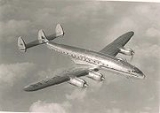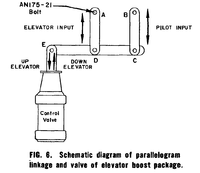
TWA Flight 529
Encyclopedia
TWA
Flight 529 was a Lockheed Constellation L-049
propliner
, registration N86511, operating as a scheduled passenger service from Boston, Massachusetts to San Francisco, California
. On September 1, 1961, at 02:05 CDT, the flight crashed shortly after takeoff from Midway Airport
(ICAO: KMDW) in Chicago
, killing all 73 passengers and 5 crew on board; it was at the time the deadliest single plane disaster in U.S. history.
The accident was investigated by the Civil Aeronautics Board, which concluded its probable cause was the loss of a 5/16 inch bolt which fell out of the elevator
control mechanism during the climb from Chicago, resulting in an abrupt pitch up
followed by a stall
and crash.
, the next stop. Five minutes later, while climbing westbound to 5,000 ft, the aircraft suddenly pitched violently upwards, resulting in an accelerated stall from which the crew was unable to recover. The aircraft crashed into terrain, and left a debris field of 200 by 1,100 feet.
 The CAB investigated the accident, and as the wreckage pieces were reassembled and scrutinized, it became apparent that a critical 5/16 inch AN-175-21 nickel steel bolt was missing in the elevator boost linkage mechanism. By carefully examining and analyzing the various scuff marks and grease patterns near the missing bolt, the CAB investigators concluded that the bolt had fallen out prior to the aircraft's disintegration and collision with the ground, and not as a result of the accident itself. Without the bolt in place, the elevator (when in boost mode) and hence the entire aircraft would become uncontrollable, leading the investigators to deduce that the bolt had fallen out, most likely by working itself loose, a short time prior to the beginning of the accident sequence.
The CAB investigated the accident, and as the wreckage pieces were reassembled and scrutinized, it became apparent that a critical 5/16 inch AN-175-21 nickel steel bolt was missing in the elevator boost linkage mechanism. By carefully examining and analyzing the various scuff marks and grease patterns near the missing bolt, the CAB investigators concluded that the bolt had fallen out prior to the aircraft's disintegration and collision with the ground, and not as a result of the accident itself. Without the bolt in place, the elevator (when in boost mode) and hence the entire aircraft would become uncontrollable, leading the investigators to deduce that the bolt had fallen out, most likely by working itself loose, a short time prior to the beginning of the accident sequence.
The design of the Lockheed Constellation L-049
aircraft allowed the pilots to disable the hydraulic
elevator boost and control the elevators manually via direct mechanical linkage. The pilots of the accident flight apparently attempted to revert to manual control as the aircraft began to pitch up, but the design was such that a continuous nose down pressure on the elevators made the shift to manual elevator control mechanically impossible. Thus, according to the CAB's reconstruction of events, as the pilots were desperately applying nose down pressure to avoid a stall, they were also hampering themselves from shifting to manual mode and regaining elevator control.
On December 18, 1962, the CAB published its final report on the accident, concluding that the probable cause was "... the loss of an AN-175-21 nickel steel bolt from the parallelogram linkage of the elevator boost system, resulting in loss of control of the aircraft."
to mandate a redesign of the elevator boost control, so that the shift to manual mode could be easily carried out by the pilots, even when applying nose down pressure. The FAA replied that they have asked the manufacturer to incorporate procedural changes in the aircraft's flight manual, but did not require any design changes.
Trans World Airlines
Trans World Airlines was an American airline that existed from 1925 until it was bought out by and merged with American Airlines in 2001. It was a major domestic airline in the United States and the main U.S.-based competitor of Pan American World Airways on intercontinental routes from 1946...
Flight 529 was a Lockheed Constellation L-049
Lockheed Constellation
The Lockheed Constellation was a propeller-driven airliner powered by four 18-cylinder radial Wright R-3350 engines. It was built by Lockheed between 1943 and 1958 at its Burbank, California, USA, facility. A total of 856 aircraft were produced in numerous models, all distinguished by a...
propliner
Propliner
A propliner is a large, propeller-driven airliner. Typically, the term is used for piston-powered airliners that flew before the beginning of the jet age, not for modern turbine-powered propeller airliners...
, registration N86511, operating as a scheduled passenger service from Boston, Massachusetts to San Francisco, California
San Francisco, California
San Francisco , officially the City and County of San Francisco, is the financial, cultural, and transportation center of the San Francisco Bay Area, a region of 7.15 million people which includes San Jose and Oakland...
. On September 1, 1961, at 02:05 CDT, the flight crashed shortly after takeoff from Midway Airport
Midway Airport
Chicago Midway International Airport , also known simply as Midway Airport or Midway, is an airport in Chicago, Illinois, United States, located on the city's southwest side, eight miles from Chicago's Loop...
(ICAO: KMDW) in Chicago
Chicago
Chicago is the largest city in the US state of Illinois. With nearly 2.7 million residents, it is the most populous city in the Midwestern United States and the third most populous in the US, after New York City and Los Angeles...
, killing all 73 passengers and 5 crew on board; it was at the time the deadliest single plane disaster in U.S. history.
The accident was investigated by the Civil Aeronautics Board, which concluded its probable cause was the loss of a 5/16 inch bolt which fell out of the elevator
Elevator (aircraft)
Elevators are flight control surfaces, usually at the rear of an aircraft, which control the aircraft's orientation by changing the pitch of the aircraft, and so also the angle of attack of the wing. In simplified terms, they make the aircraft nose-up or nose-down...
control mechanism during the climb from Chicago, resulting in an abrupt pitch up
Flight dynamics
Flight dynamics is the science of air vehicle orientation and control in three dimensions. The three critical flight dynamics parameters are the angles of rotation in three dimensions about the vehicle's center of mass, known as pitch, roll and yaw .Aerospace engineers develop control systems for...
followed by a stall
Stall (flight)
In fluid dynamics, a stall is a reduction in the lift coefficient generated by a foil as angle of attack increases. This occurs when the critical angle of attack of the foil is exceeded...
and crash.
Flight history
The four-engine propliner originated in Boston, and after making intermediate stops in New York and Pittsburgh, arrived at Chicago Midway Airport at 01:18 CST, where a new crew took over, and fuel and oil were added. At 02:00 the flight departed from runway 22, bound for Las Vegas, NevadaLas Vegas, Nevada
Las Vegas is the most populous city in the U.S. state of Nevada and is also the county seat of Clark County, Nevada. Las Vegas is an internationally renowned major resort city for gambling, shopping, and fine dining. The city bills itself as The Entertainment Capital of the World, and is famous...
, the next stop. Five minutes later, while climbing westbound to 5,000 ft, the aircraft suddenly pitched violently upwards, resulting in an accelerated stall from which the crew was unable to recover. The aircraft crashed into terrain, and left a debris field of 200 by 1,100 feet.
Investigation

The design of the Lockheed Constellation L-049
Lockheed Constellation
The Lockheed Constellation was a propeller-driven airliner powered by four 18-cylinder radial Wright R-3350 engines. It was built by Lockheed between 1943 and 1958 at its Burbank, California, USA, facility. A total of 856 aircraft were produced in numerous models, all distinguished by a...
aircraft allowed the pilots to disable the hydraulic
Hydraulic drive system
A hydraulic drive system is a drive or transmission system that uses pressurized hydraulic fluid to drive hydraulic machinery. The term hydrostatic refers to the transfer of energy from flow and pressure, not from the kinetic energy of the flow....
elevator boost and control the elevators manually via direct mechanical linkage. The pilots of the accident flight apparently attempted to revert to manual control as the aircraft began to pitch up, but the design was such that a continuous nose down pressure on the elevators made the shift to manual elevator control mechanically impossible. Thus, according to the CAB's reconstruction of events, as the pilots were desperately applying nose down pressure to avoid a stall, they were also hampering themselves from shifting to manual mode and regaining elevator control.
On December 18, 1962, the CAB published its final report on the accident, concluding that the probable cause was "... the loss of an AN-175-21 nickel steel bolt from the parallelogram linkage of the elevator boost system, resulting in loss of control of the aircraft."
Aftermath
As a result of their investigation of the accident, the CAB urged the FAAFederal Aviation Administration
The Federal Aviation Administration is the national aviation authority of the United States. An agency of the United States Department of Transportation, it has authority to regulate and oversee all aspects of civil aviation in the U.S...
to mandate a redesign of the elevator boost control, so that the shift to manual mode could be easily carried out by the pilots, even when applying nose down pressure. The FAA replied that they have asked the manufacturer to incorporate procedural changes in the aircraft's flight manual, but did not require any design changes.

